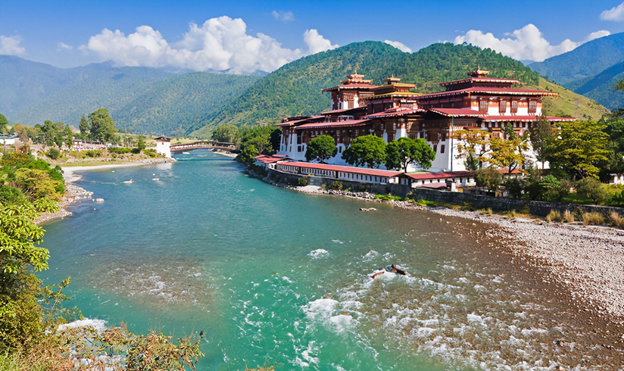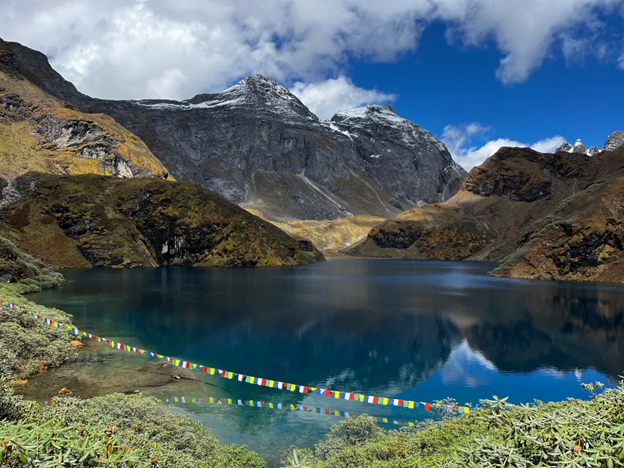Known by many as the “Land of the Thunder Dragon,” Bhutan is a country that skillfully combines profound spiritual traditions with its abundant natural beauty. Bhutan has many treasures, but its sacred lakes are among its most important mystical and spiritual assets. Beyond being breathtaking natural structures, these lakes are sacred places of devotion and pilgrimage, steeped in centuries-old myths and traditions.
You could explore the lakes yourself on a Bhutan tour. One of the best time to visit is September through November. Bhutan in autumn has a charm that is unlike any other place you’ll see in your lifetime.
The Legend of the Hidden Treasures
A lot of Bhutan’s holy lakes are connected to the idea of “Ters,” or hidden riches thought to have been kept secret by Tibetan Buddhist founder Guru Rinpoche (Padmasambhava) in the eighth century. These treasuries are rumoured to hold holy books, artefacts, and spiritual objects intended to be found by tertons (treasure revealers) during lucky periods to further humanity spiritually.
Sacred Lakes in Bhutan

Jomo Tsho, or Lake Jomo: Tucked up in the Lhuntse district’s mountains, Jomo Tsho is regarded as one of most revered among the many of Bhutan’s sacred lakes. It has to do with the strong protector spirit, Jomo. To get to this calm and immaculate lake, pilgrims must walk over difficult terrain. There, they present sacrifices and carry out rituals in order to ask Jomo for favours. Amazing beauty all around the lake heightens the spiritual experience.
Another hallowed location is Lake Lugu (Luguthang Tsho), which is situated in the isolated Laya area of the Gasa district. The lake is said to be the home of a naga, a snake deity, and local folklore describes its kind and guarding quality. To honour their ancestors and to get protection from the naga, pilgrims flock to the lake. The difficult trek to Lake Lugu reflects the pilgrims’ fervour and faith.
Lake Tshophu (Tshophu Tsho): Located in the magnificent Paro Valley, Lake Tshophu is particularly significant in Bhutanese spirituality. Often, pilgrims arrive during the yearly religious holiday, when the neighbourhood comes alive with rituals and festivities. Prayer are best done in the calm waters of the lake and the adjacent alpine meadows.
Bhutan’s Sacred Lakes Myths and Legends
Bhutan’s holy lakes are all encircled in tales and traditions that heighten their ethereal appeal. Generation after generation of people have woven these tales into the national cultural and spiritual fabric.
The Vanishing Lakes: It’s thought that a number of Bhutanese holy lakes have the capacity to disappear and then resurface. These lakes, so the legend goes, can move to prevent defilement or to hide their riches from people who are judged undeserving. The fact that pilgrims think the lakes only reveal themselves to the devoted and pure-hearted lends mystique and awe to the experience.
The Guardian Spirits: Bhutan’s hallowed lakes are frequently portrayed as ferocious defenders who uphold the locations’ sacredness. These gods are important to the local folklore and are worshipped with sacrifices and ceremonies. The lakes are well-known as potent spiritual hubs because of the numerous accounts of contact with these ghosts.
The Conservation of Bhutan’s Sacred Lakes

The Bhutanese holy lakes are important ecological resources in addition to being spiritual gems. They provide supplies of clean water, sustain a variety of habitats, and add to the breathtaking scenery that draws visitors from all over the world. Human activity, environmental deterioration, and climate change present problems for these lakes, though.
Impact of Climate Change: Bhutan’s sacred lakes are seriously threatened by climate change. The holiness of the lakes and the nearby ecosystems may be impacted by variations in water levels brought on by glacial melting and shifting weather patterns. Using conservation programmes and sustainable practices, attempts are being undertaken to track and lessen these effects.
Juggling Tourism and Preservation: Bhutan’s holy lakes suffer from both the benefits and drawbacks of tourism. It can stress the environment, even if it encourages cultural interchange and has economic advantages. The Bhutanese government works to reconcile the number of tourists with the necessity to maintain the sacredness and ecological health of these locations, driven by its policy of high-value, low-impact tourism.
Community Involvement: Bhutan’s sacred lakes are conserved in large part by the local community. Modern conservation methods, along with traditional knowledge, help preserve these priceless locations. Sustainable practices are encouraged and the spiritual and ecological worth of the lakes is preserved for future generations through community-based projects.
Conclusion
For the Bhutanese people, the holy lakes are more than simply pools of water; they are ethereal and spiritual havens. They embody the complex interplay between spirituality and nature that is a feature of Bhutanese culture. The Bhutanese uphold their customs while adjusting to the demands of a world in transition.
The calm beauty, evocative stories, and deep spirituality of Bhutan’s holy lakes provide a singular window into the spirit of the country. Bhutan makes sure that its spiritual and cultural legacy continues by protecting these holy rivers and offering comfort and inspiration to everyone who visits its enchanted shores.




